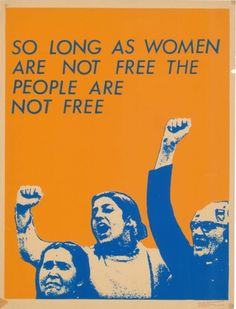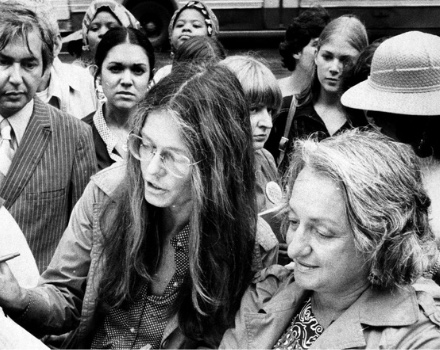Dear Mom,
Today we are talking about the second wave of feminism. In order to do this properly, you need to understand the context in which second wave feminist movement took place.
Why did second wave feminism start
The twentieth century brought with it numerous changes. The biggest events, of course, were the two world wars, after which nothing was the same anymore.
Role of women during the wars
During the First and Second World Wars, women did a lot of things at the same time. I guess, like they have always done it. This time, the difference was that they were in charge of the factories in which their husbands used to work. Women also, understandably, took care of the family, their household, put bread on the table. When the husbands returned from the wars, the women put on the housewife’s suit again, while the men tried to find their place in the working life. As you can imagine, Mom, the economic crisis was great and women did not have a priority to get a job. What a man earned had to be enough for the entire family. The full on consumption was still not a thing.
There have never been as many housewives as in the period between the two wars and immediately after the Second World War. This model, the so-called traditional gender model, was considered functional when considering the economic and social circumstances at the time. It was accepted by the society. I cannot even imagine how women felt when they were all of a sudden obliged to leave jobs and be housewives again. Some, probably, relieved. No, Mom, I am not judging, I swear! I fully understand the context in which these things happened.

Changes after the Second World War
After the Second World War, consumerism emerged, numerous household appliances appeared that made life easier for housewives. New generation was born with a television, more and more girls went to college. Demographics had changed, the population was young, the baby-boomers were born. This being said, Mom, within this new context, the new generations wanted different things from their parents, the mentalities changed.
In the 50s and 60s, more and more women started working. There was more work “adapted to women”. However, this was a double-edged sword. Working conditions for women were very difficult, women were paid very little, and on top of that they experienced sexual harassment at work. They also still had to take care of their children and the household.

First wave feminism
When did feminism start, you are asking? You are right, in order to understand the second wave of feminism, was obviously preceded by the first one marked by the struggle for the right to vote, the right to inheritance, the right to divorce.
In Yugoslavia, women won the right to vote in 1945, and in France a year earlier – in 1944. But do not get tricked, Mom! It is believed that this law was passed in France because De Gaulle saw in women a strong electorate, which he could use for the upcoming presidential elections. In his favor, of course.
Although the period between 1920 and 1960 is considered to have been a lull for feminists, it was during this period that the most significant feminist work emerged. Those led women to think differently and ask themselves numerous questions that had never been asked before. Second Sex of Simon de Beauvoir was published in 1949 and it inspired many other writers, from all over the world. One of the most significant works in the United States, the basis for the second wave of feminism in this country, is the work of Betty Friedan’s Women’s Mysticism. In this book, Friedan cites theses, in which she claims that a woman can experience her full potential precisely by leaving the house and being something other than a housewife, and that the whole society will benefit from this, not just women.

When did second wave of feminism start?
The second phase of feminism began during the 1960s and 1970s.
This is a period of great emancipation of women on the intellectual, and therefore economic level. In the second wave of feminism, the family as such, the job, the rights related to childbirth are re-examined.
The big topic is sexuality.
The first official safe houses are being opened.
The raped women are being supported for the first time.
This movement gained a political, but also a social dimension, many types of feminism emerged. You already read, Mom, in When did feminism start? that the feminist movement is not homogeneous and that we usually have several different currents. In the United States, the National Women’s Party and the League of Women Voters were formed. The first group wanted gender discrimination to be prohibited by law, while the second wanted women to have privileged rights at work. The second group, as you might imagine, attracted many more women, especially those from the middle class.

Sexual liberation during the second wave feminism
During this period, young people wanted sexual liberation. They re-examined the hierarchical system coming from the patriarchy, known to all. The new generations wondered if things could be different and wanted to invent new rules.
Thus, various movements are emerging in the United States, such as the hippie movement, which, at the same time, fought against the war in Vietnam. The famous May 1968 took place in France, which marked the struggle of young people for sexual liberation. In Yugoslavia, there were also students’ demonstrations in May 1968, but students protested because of class differences. Young people were not satisfied with socialism in their country, they noticed that there was no real equality in society, as depicted in the media.
Although we can see communism as an advanced political ideology in favor of gender equality, in many communist countries, women were not treated as equals when they joined the class struggle and their left-wing male comrades. You know, Mom, the difference between the sexes was not supposed to be present in the class struggle, but this wasn’t always the case.

Abortion and contraception
Abortion and contraception were very much hidden. Can you believe, Mom, that contraception, all advertisements for condoms, as well as abortion were banned in France in 1920? On the other hand, abortion has been legal in the URRS since 1917.
In 1960, birth control pills finally became legal in the United States, in Yugoslavia in 1965. Second wave feminists organized debates and workshops in which they educated women about the importance of using protection, sexually transmitted diseases and abortion. Because, Mom, do you remember Woodstock and belief in free love? Awareness of protection was not prevalent and it was necessary to work on it, it was not enough for the pill to appear. It also needed marketing and sexual education chats.

Problems with contraceptives
Now, we have two problems here. We ‘’were given’’ the pill, but we should not be naïve and simply grateful. We should rather ask ourselves, how come contraceptive pills were invented only for women? Why weren’t they invented also for men? Wait, Mom, we are fertile only few days a month, while men are fertile every single day. All responsibility is transferred, as usual, to us. Hello! As I know, the intercourse is between two people, they are both accountable for their actions!
The problem with the birth control pills was that you needed a prescription for it in multiple countries. You cannot, even today, go to the doctor without the knowledge or accompaniment of one of your parents in many places. And realistically, how many underage girls openly tell their parents that they are sexually active? It’s again about the control. While the boys sit quietly at home and play video games, girls are the ones that have to find a way. That is why many underage girls are still pregnant in the 21st century in, what we call, the developed countries.
I don’t think second wave feminists imagined the 21st century exactly like this. I often wonder what would Simon de Beauvoir say now if she was alive?

Fight for abortion in France
At the beginning of the second wave feminism movement, something very interesting happened in France. Simon de Beauvoir, together with other activists, actresses, journalists, writers, and others, wrote Manifesto 343. That number – 343 – represents 343 women who had abortions and publicly acknowledged it. These women risked going to prison because abortion was prohibited by the law at the time. As it is still in many countries today. But they wanted to show that, whether the law existed or not, women had abortion. They always found a way and thus risked their own lives. Manifesto 343 was there to show that women should make important decisions in concern to their own body and not have someone else tell them what they are entitled to.
Abortion was finally legal in France in 1975.


Goals of second wave feminism
As you can see, Mom, main goal of the second wave of feminism is for women to become a subject. Women want to be active participants of their lives, they don’t want to be someone’s, they realized they could be independent.
Second wave of feminism accomplishments
This raised a lot of questions such as: Can a woman be happy if she has no children? What about if she doesn’t get married? Can a job make a woman happy? Can she be happy for no reason?
Can a woman be?
Also how patriarchy came into being? What are the values of heterosexual femininity and who determines them? Are women really the weaker sex and what makes them vulnerable? Also psychological theories appeared about how girls and boys adopt and appropriate gender identity with dominance.

At the same time, anti-feminists appear, who in their books condemn feminists for being responsible for the misfortune of many women who were left alone. They also talk about the fact that a woman will never feel like a real woman if she is not a mother. While everyone is getting used to and largely rejecting numerous changes, unmarried women are stigmatized, excluded from society, children of divorced parents as well.
We should still be careful
The second wave brought the search for numerous rights that we are still fighting for today or that are very fragile. Many of those change depending on who comes to power. Great economical or sanitary crises are also very often excuses to take away certain rights that women fought for. That is why we always need to be on the watch and careful.
And that is also why it is important that women educate themselves, be aware of the oppression of patriarchy and be on the deciding positions as much as men.
Until the next letter,
Love you,
Biljana







No Comments